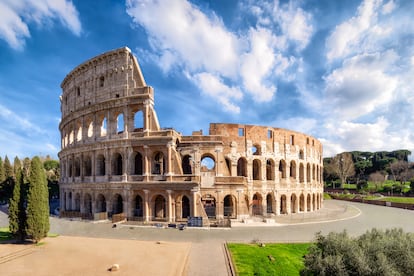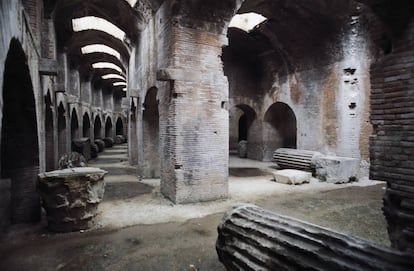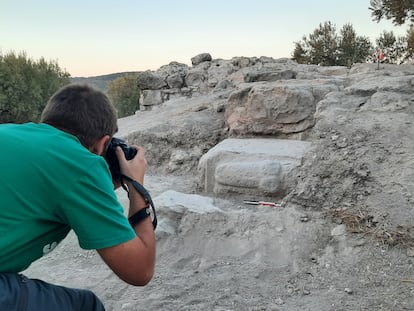The self-repairing concrete that keeps the Colosseum standing
The cement used to construct the ancient Roman amphitheater is more durable than the type used today because of a special ingredient

If you tried to batter the concrete joints of the Roman Colosseum with a pickaxe, the point would probably bounce off without even a tiny piece of gravel crumbling. After repeated blows, a crack might eventually appear. But then something surprising would happen – in less than two weeks the crack would close up. All by itself. When exposed to air, the concrete mends itself. Although people have been studying Roman concrete since the 1960s, the secret behind this mysterious property has only been recently revealed.
In early January, universities in Italy, Switzerland and the United States published the latest scientific study on Roman cement. It was once thought that the cement’s durability was due to the use of pozzolan, a volcanic rock found near the small town of Pozzuoli, on the slopes of Mount Vesuvius near Naples. But now we know these long-lasting Roman buildings have withstood the passage of time because of the purity of their materials and a special ingredient – quicklime. Paradoxically, the Romans built structures using a substance known for its corrosive properties.
Concrete is usually made by mixing two ingredients. Gravel is the component that makes up the bulk of the composite. One reason Roman concrete is so durable is because it used a very pure gravel quarried in Pozzuoli and transported throughout the Roman Empire. The key is in the second ingredient: the binder or glue that holds the gravel together. It is well-known that the Romans used cold lime mixed with water for the binding ingredient. “Vitruvius, the renowned Roman architect, wrote that lime should be kept hydrated for at least six months,” says Pablo Guerra, an archaeologist and professor at the University of Castilla-La Mancha in Spain. Guerra, who wrote his doctoral thesis on Roman building materials, explains that mixing gravel and slaked lime causes a chemical reaction that binds the concrete we all know today.
So, what did all these universities from around the world recently discover about Roman concrete? They found that Roman builders added quicklime to the traditional mixture of gravel and slaked lime. The quicklime had to be fresh from the oven and still burning during the mixing process. Quicklime is the reason for the extraordinary durability of the great buildings of Rome, and also why they took much less time to build.
“Quicklime accelerates the hardening of concrete and makes it stronger if added during the mixing process. It also enables the material to react well to air exposure because the concrete’s pores seal themselves when they come into contact with carbon in the environment,” says Guerra. This is why, centuries after it was erected, a crack in a Roman building will seal itself in a matter of days. It’s also the reason why the concrete used in the Colosseum and the Pantheon of Agrippa was never reinforced with other materials. This cement mix could be used in very large buildings as well as in very finely crafted mosaics, such as the ones in the Roman villa of Noheda in Spain. When the gravel in the mix is very small and the cement can inserted in narrow spaces, it’s called mortar.

Better than modern cement
“Roman cement is the best. No civilization in history, including our own, has ever produced such durable concrete. Until this latest study, its durability has always been attributed to pozzolan sand. This discovery has the potential to revolutionize our own construction methods,” says Carmen Martínez, a doctoral candidate in Roman archaeology in Cartagena, southeast Spain, where she has worked for the last 12 years. “I remember an excavation where we had to remove an enormous piece of Roman concrete,” adds Martínez. “No matter how hard we hacked, we couldn’t do it. I can’t think of that happening with any other material.”
With all our modern technological advances, it’s natural to wonder why our concrete is weaker than it was in Roman times. “It may surprise some to learn that the Romans did not know about the chemistry of materials. They worked by trial and error, and were very good at selecting and using the best materials,” says Guerra. He agrees that Roman cement is the most durable and can contribute to improving modern construction.
Roman concrete was also exceptional for political reasons – it supported the perception of a stable and productive state. “Unlike us, the Romans never built 15,000 houses at once. Why would they do that? They built a lot, but in a more balanced way,” says Guerra. When Guerra begins a restoration project, he makes his own cement mix instead of buying it in bags, and follows the Vitruvian recipe of soaking the lime for at least six months. He then sifts the gravel himself to obtain the highest quality aggregate, just like the Romans did. Guerra says this not only makes the concrete more durable, it’s also ecologically friendly. In fact, the Wikipedia entry for pozzolana describes it as an eco-material.
Historians aren’t the only ones who praise Roman cement as being better than its modern equivalent. Alfonso Barrón, an architect and materials expert, agrees. “In addition to its self-mending property, the lime in Roman concrete becomes harder over the years. Over time, it turns back into limestone, the original rock from which it was extracted – it becomes younger and stronger. Meanwhile, Portland cement, which we have been using since the 19th century, does the opposite – it ages and decays.”
Sign up for our weekly newsletter to get more English-language news coverage from EL PAÍS USA Edition
Tu suscripción se está usando en otro dispositivo
¿Quieres añadir otro usuario a tu suscripción?
Si continúas leyendo en este dispositivo, no se podrá leer en el otro.
FlechaTu suscripción se está usando en otro dispositivo y solo puedes acceder a EL PAÍS desde un dispositivo a la vez.
Si quieres compartir tu cuenta, cambia tu suscripción a la modalidad Premium, así podrás añadir otro usuario. Cada uno accederá con su propia cuenta de email, lo que os permitirá personalizar vuestra experiencia en EL PAÍS.
¿Tienes una suscripción de empresa? Accede aquí para contratar más cuentas.
En el caso de no saber quién está usando tu cuenta, te recomendamos cambiar tu contraseña aquí.
Si decides continuar compartiendo tu cuenta, este mensaje se mostrará en tu dispositivo y en el de la otra persona que está usando tu cuenta de forma indefinida, afectando a tu experiencia de lectura. Puedes consultar aquí los términos y condiciones de la suscripción digital.
More information
Archived In
Últimas noticias
Most viewed
- Reinhard Genzel, Nobel laureate in physics: ‘One-minute videos will never give you the truth’
- Oona Chaplin: ‘I told James Cameron that I was living in a treehouse and starting a permaculture project with a friend’
- Pablo Escobar’s hippos: A serious environmental problem, 40 years on
- Charles Dubouloz, mountaineering star, retires at 36 with a farewell tour inspired by Walter Bonatti
- Why we lost the habit of sleeping in two segments and how that changed our sense of time











































